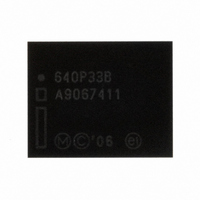PC28F640P33B85A NUMONYX, PC28F640P33B85A Datasheet - Page 55

PC28F640P33B85A
Manufacturer Part Number
PC28F640P33B85A
Description
IC FLASH 64MBIT 85NS 64EZBGA
Manufacturer
NUMONYX
Series
StrataFlash™r
Datasheet
1.PC28F640P33B85A.pdf
(96 pages)
Specifications of PC28F640P33B85A
Format - Memory
FLASH
Memory Type
FLASH
Memory Size
64M (4M x 16)
Speed
85ns
Interface
Parallel
Voltage - Supply
2.3 V ~ 3.6 V
Operating Temperature
-40°C ~ 85°C
Package / Case
64-TBGA
Cell Type
NOR
Density
64Mb
Access Time (max)
85ns
Interface Type
Parallel/Serial
Boot Type
Bottom
Address Bus
22b
Operating Supply Voltage (typ)
2.5/3/3.3V
Operating Temp Range
-40C to 85C
Package Type
EZBGA
Sync/async
Async/Sync
Operating Temperature Classification
Industrial
Operating Supply Voltage (min)
2.3V
Operating Supply Voltage (max)
3.6V
Word Size
16b
Number Of Words
4M
Supply Current
28mA
Mounting
Surface Mount
Pin Count
64
Lead Free Status / RoHS Status
Lead free / RoHS Compliant
Other names
888226
888226
PC28F640P33B85
PC28F640P33B85 888226
888226
PC28F640P33B85
PC28F640P33B85 888226
Available stocks
Company
Part Number
Manufacturer
Quantity
Price
Company:
Part Number:
PC28F640P33B85A
Manufacturer:
Micron Technology Inc
Quantity:
10 000
Numonyx™ StrataFlash
11.1.0.11
11.1.0.12
11.2
11.2.1
Note:
November 2007
Order Number: 314749-05
Burst Length
The Burst Length bits (BL[2:0]) selects the linear burst length for all synchronous burst
reads of the flash memory array. The burst lengths are 4-word, 8-word, 16-word, and
continuous word.
Continuous burst accesses are linear only, and do not wrap within any word length
boundaries (see
cycle begins, the device outputs synchronous burst data until it reaches the end of the
“burstable” address space.
End of Word Line (EOWL) Considerations
When performing synchronous burst reads with BW set (no wrap) and DH reset (1-
clock cycle), an output “delay” requiring additional clock Wait States may occur when
the burst sequence crosses its first device-row (16-word) boundary. The delay would
take place only once, and will not occur if the burst sequence does not cross a device-
row boundary. The WAIT signal informs the system of this delay when it occurs. If the
burst sequence’s start address is 4-word aligned (i.e. 0x00h, 0x04h, 0x08, 0x0Ch) then
no delay occurs. If the start address is at the end of a 4-word boundary (i.e. 0x03h,
0x07h, 0x0Bh, 0x0Fh), the worst case delay (number of Wait States required) will be
one clock cycle less than the first access Latency Count (LC-1) when crossing the first
device-row boundary (i.e. 0x0Fh to 0x10h). Other address misalignments may require
wait states depending upon the LC setting and the starting address alignment. For
example, an LC setting of 3 with a starting address of 0xFD requires 0 wait states, but
the same LC setting of 3 with a starting address of 0xFE would require 1 wait state
when crossing the first device row boundary.
Read Operations
The device can be in any of four read states: Read Array, Read Identifier, Read Status
or Read Query. Upon power-up, or after a reset, the device defaults to Read Array
mode. To change the read state, the appropriate read command must be written to the
device (see
sections describe read-mode operations in detail.
The device supports two read modes: asynchronous page mode and synchronous burst
mode. Asynchronous page mode is the default read mode after device power-up or a
reset. The RCR must be configured to enable synchronous burst reads of the flash
memory array (see
register. It functions independent of VPP. The WSM sets and clears SR[7,6,2], but it
sets bits SR[5:3,1] without clearing them. The Status Register should be cleared before
starting a command sequence to avoid any ambiguity. A device reset also clears the
Status Register.Read Configuration Register” on page
Asynchronous Page-Mode Read
Following a device power-up or reset, asynchronous page mode is the default read
mode and the device is set to Read Array mode. However, to perform array reads after
any other device operation (e.g. write operation), the Read Array command must be
issued in order to read from the flash memory array.
Asynchronous page-mode reads can only be performed when RCR 15 is set
The Clear Status Register command clears the status register. It functions independent
of VPP. The WSM sets and clears SR[7,6,2], but it sets bits SR[5:3,1] without clearing
them. The Status Register should be cleared before starting a command sequence to
avoid any ambiguity. A device reset also clears the Status Register.
®
Embedded Memory (P33)
Section 9.6, “Device Command Bus Cycles” on page
Table 29, “Burst Sequence Word Ordering” on page
Section , “The Clear Status Register command clears the status
49).
44). The following
54). When a burst
Datasheet
55












